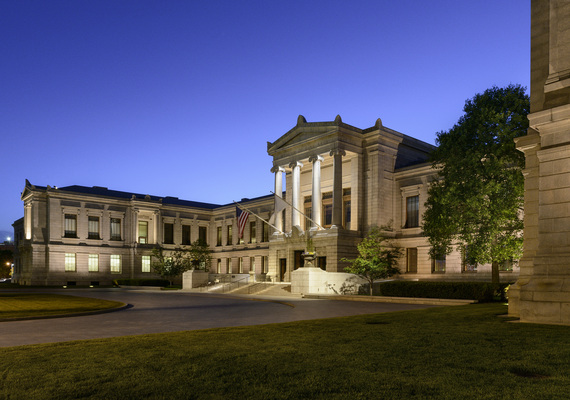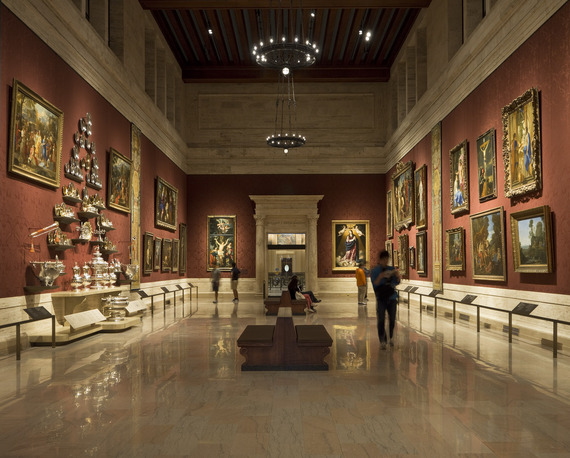The grand Koch Gallery at Boston's Museum of Fine Arts boasts 16th century and 17th century European artists like Titian.
It's an unexpected place to be reminded of the Holocaust - the Nazi's murderous genocide that played out four centuries later across Europe .
But a visit to the magnificent gallery echoes with the reverberations of the Holocaust through seemingly unrelated works of art: four 17th century tapestries from the Barberini Palace in Rome that hang on opposite walls serve as a cultural commemoration for Yom Hashoah, Holocaust Remembrance Day that was observed this week.
Alongside the descriptive text panels that explain the tapestry's imagery and historical context, visitors can read separate text panels that offer the behind-the-scenes story of how the MFA came to own the tapestries. It's to the credit of the MFA that they offer visitors the opportunity to learn about the connection between the museum's treasured art and this still unfolding dark chapter of history.
The colorful tapestries, made of wool and silk, are striking in their size, measuring nearly 18 feet long, and 4 feet wide. According to the museum, they are part of a larger series that glorifies the life and achievement of Pope Urban VIII (Maffeo Barberini), who lived from 1568-1644. They originally hung in the Barberini Palace in Rome until the end of the 19th century, when they were sold.
The MFA's quartet of tapestries were part of 14 vertical border panels that each illustrates a specific theme in a medallion. The ornamented designs include the Barberini bee in yellow and a red swag with pendants of laurel leaves, a mask and a large jar of flowers. All weave in family and papal legacy with Church imagery.

Tapestry: The Palazzo dell' Annona (from THE LIFE OF POPE URBAN VIII). Manufactured by: Barberini Manufactory; Italian (Rome), 1663-1679. Museum of Fine Arts, Boston. Gift of Eugene L. Garbáty in memory of his parents, Josef and Rosa Garbáty and Charles Potter Kling Fund. Photograph ©
The tapestries were given to the MFA in the 1950s by Eugene Garbaty, a German Jewish art collector and refugee, in memory of his parents, Josef and Rosa Garbáty.
In March 2011, the MFA's Provenance Research department made public that through their research, spearheaded by provenance curator Victoria Reed, they had discovered that the tapestries had been included in a forced sale of the art dealership Margraf and Co. in Berlin run by Jakob and Rosa Oppenheimer.
Both Jackob and Rosa Oppenheimer lost their lives in the war, Jakob died in France and Rosa at Auschwitz, according to the MFA. Garbaty, who bought the tapestries shortly after they sold at auction, in 1935, was unaware they had belonged to Margraf or been involved in a forced sale, the MFA explained in its press statement.
The museum reached out to the Oppenheimer's heirs.
"We were pleased to inform the heirs of this discovery, and to work with them on a resolution, which now gives the tapestries a permanent home at the Museum," then MFA director Malcolm Rogers said in a statement.
Under Reed's curatorial leadership over many years, the MFA has made its provenance research accessible. Text panels labeled Art with a Past, are now found throughout the museum - in galleries with centuries-old art such as in the Koch Gallery - and in modern art galleries, as well. More detailed, extensive resources are available on the website of the museum's Provenance Department including lists of works whose provenance has been resolved and others still being reviewed.
Holocaust-era Menorah donated by Monuments Men Foundation
In a related story, JTA reported this week that the Monuments Men Foundation for the Preservation of Art donated a seven-branch menorah to the Dallas Holocaust Museum. The menorah was among the thousands of works of art and cultural objects looted by the Nazis.
The little-known story of the Monuments Men, a group of international allied forces who saved more than 5 million works of the Nazi stolen art, was told in a 2014 film starring George Clooney, Cate Blanchettt and Matt Damon. It was based on the 2009 book by Foundation founder Robert Edsel.
"The Monuments Men Foundation is pleased that after some 70 years, this menorah will now have a permanent and appropriate home at one of our city's most important cultural institutions, the Dallas Holocaust Museum/Center for Education and Tolerance," Edsel said in the JTA article
"Now, after a very long journey, it will serve future generations as an ever present reminder of the horrors inflicted on humanity by Adolf Hitler and the Nazis."


